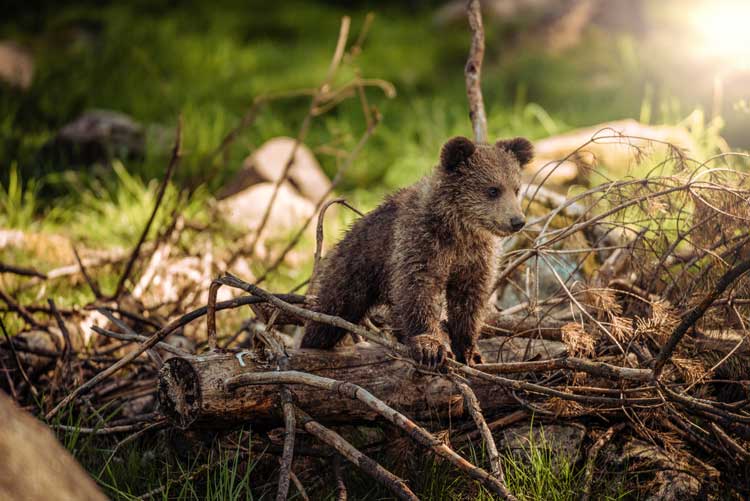
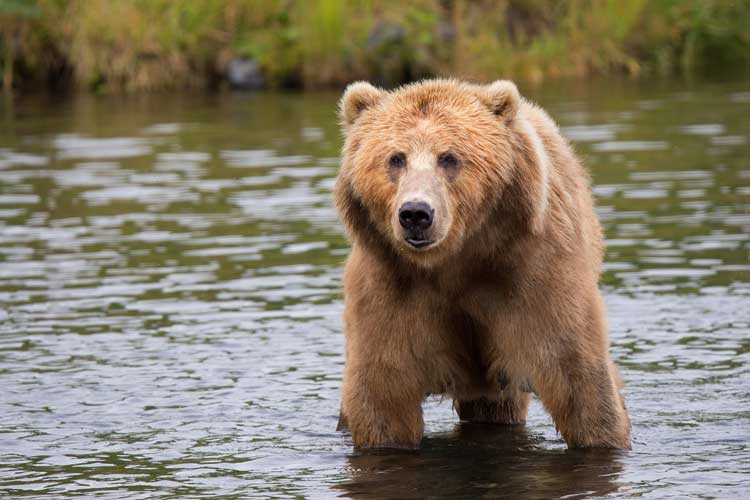
“You forgot to mention,” my husband says, “that we would be traipsing so close to them.”
Bear Viewing in Alaska
“Them” refers to two 1,000-pound Alaskan bears 50 yards away. I don’t answer him – as the four-inch claws furiously foraging the meadows rivet my attention. We are following our naturalist, Sarah Elg, single file. Her familiarity with the area and its inhabitants provides reassurance as we scamper past the hulking giants.
Trudging along toward the scrubland, I reflect on my partners’ comment. The wilderness existed at the periphery of his upbringing. He led an urban existence, playing semi-professional tennis and competing in triathlons for fun.
My family, on the other hand, pursued wildlife viewing with religious fervor. Strenuous hikes to view an elusive squirrel or enduring 110-degree weather for a glimpse of a tiger were commonplace for us.

Katmai National Park
Mac acquiesced when I suggested bear viewing in Katmai National Park in Alaska as an anniversary marker. As our trip approached, he dreamed of bears chasing him. In his reverie, he would outrun them. Once he learnt that they sprint at 35 miles an hour, he seemed concerned.
Ursine nightmares notwithstanding, in early summer we head to the artsy town of Homer, Alaska. Craig Elg, our pilot, is prepping for our flight across the Cook Inlet. We cram into the dancing floatplane, outfitted in thigh-high gaiters. This is travel in Alaska.
The aircraft taxies past nesting swans before making a gentle leap skywards. We fly over halibut-fishing trawlers and backstroke practicing otters. A whale pod cavorts below us. In the distance, Mount Augustine dozes on its island while Iliamna struggles to peer above the clouds.
Then the Pacific Coast of Katmai extends before us, flanked by tidelands and hoary mountains. The bay stretches out to Shelikof Strait – Kodiak Island lies across. Curvy glaciers glissade down the spine of the Aleutian Range. This is fire-breathing ice; a parade of volcanoes strung across like pearls.
Novarupta’s 1912 eruption, the largest in the twentieth century and fifth biggest in recorded history, endowed the area with protected status in 1918. Katmai received national park classification under the Alaska National Interest Lands Conservation Act of 1980 and expanded to 4 million acres.
Wilderness preservation led to abundant salmon runs, reeling in anglers and bears. Eventually, the bruins became the centerpiece. Their current population stands at 2,100, with a density of 551 per 386 square miles in the nutrient-rich coastal areas. (In comparison, Montana’s Glacier National Park, boasts 30 per 386 square miles, the highest in the continental U.S.)
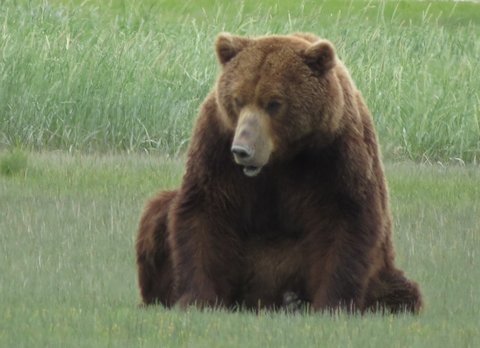
“Stay 50 yards away from animals,” instructs Sarah. “Walk close together as a group to appear larger. Clap your hands while rounding corners. It has never happened, but all of us need to adhere to strict rules to ensure both the comfort and respect of bear/human interaction so that neither interferes with the other.” She assures us she is carrying survival gear, a marine flare and a satellite radio.
As we walk along the coastal strip, a sow (a female bear) lolls in the sand, resting her portly tummy in a pit. She stares at us, yawns, and goes back to lounging. More intrepid sows are digging for clams in the inter-tidal zone.
Bears After Hibernation
Six months of hibernation and a hungry spring later, the grizzlies are devouring the grasslands. According to the National Park Service, Lyngbye’s sedge is relatively high in protein, so it tides the bears over until the salmon runs begin.
Mac motions toward a burly male wooing his lady. After numerous advances, beseeching glances and coaxing grunts, he succeeds in his mission. Their mating ritual, a union interspersed with nuzzling and love bites, lasts for half an hour. Then it’s munching time again.
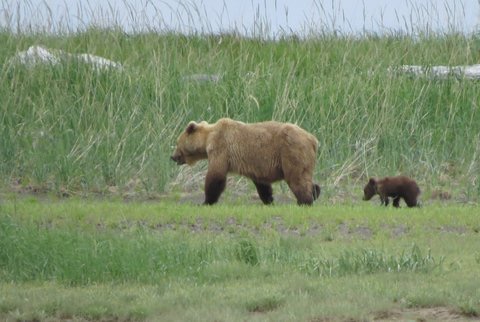
A mamma bear spots us in the midst of a braided stream. Her hackles raised, she issues a warning growl; bugger off. Her gangly-limbed yearling – head and ears looming large above his body – observes us with wide-eyed curiosity. Sarah gestures us to wait. Rule 2: sows with cubs merit double the safety distance. We change direction and wade further away from them.
Watching the gorging orgy triggers our hunger pangs. We had strict instructions to avoid bringing fish and spilling any crumbs on the ground to prevent the bruins from associating humans with food; a recipe for disaster. We sit on a log and hunch over our lunches.
Around us, 25 ursus arctos horribilis are grazing like cattle. Dressed in their summer finery, the bears’ coats glisten in the sunlight. They cover the whole gamut of brown – from silt to Irish beer. Resting against a tree trunk, Mac insouciantly flicks off clumps of ursine hair from his shirt. Somebody else had found the bark comfortable too; as a bear rub. Grizzlies scratch their backs on trees, marking territories with their scent.
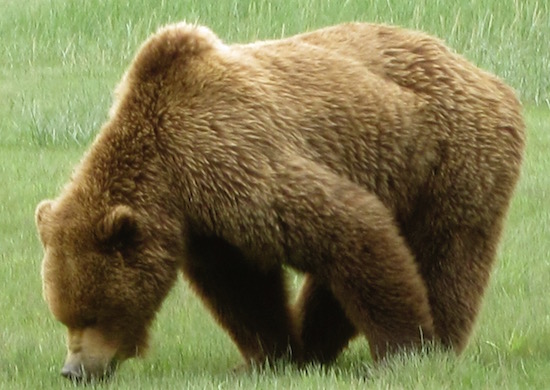
The droning of wheel planes breaks our trance. Bear viewing has mushroomed in popularity – across the park in Brooks Falls, more than 200 visitors come to gaze upon the grizzles a day, according to Katherine Ringsmuth in her 2013 book At the Heart of Katmai. The roughly 39,000 annual visitors contribute $37 million to the state’s economy. BBC’s Great Bear Stakeout and Disney’s Bears were both partially filmed here.
“Katmai offers some of the best bear-viewing in the world,” says Sarah. Most of the folks she guides are drawn to it because of their passion for nature and photography, she adds.
By late afternoon, the intense northern sun is lulling the residents into a siesta. We are meandering our way back to the plane, when a newcomer swaggers onto the scene like a Roman gladiator. Battle-scarred face. Patches of fur missing. A lord-of-the-manor gait. Other males eye him warily.
The females slink away. Watching his aggressive posturing, scenes from Werner Herzog’s Grizzly Man replay in my head. “We may find ourselves inside a hungry stomach,” I muse, “à la Timothy Treadwell.”
I am unaware I have vocalized these words until a familiar hand leads me away from the melee and into the aircraft.
If You Go
Katmai National Park
https://www.nps.gov/katm/index.htm
Bear Viewing
https://www.nps.gov/katm/planyourvisit/bear-watching.htm
Emerald Air Services
https://www.emeraldairservice.com
Air taxi service offering guided trips
Homer Visitor’s Guide
https://homeralaska.com
- Travel Guide to Austria - April 17, 2024
- Travel Guide to Italy - April 17, 2024
- Travel Guide to Germany - April 17, 2024
